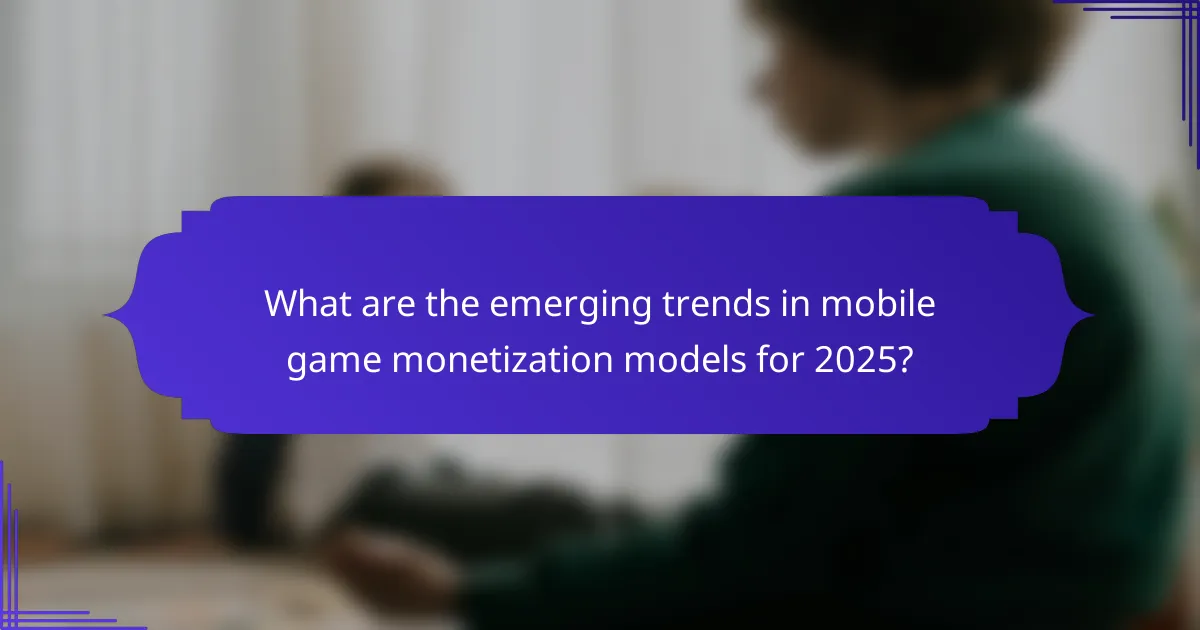The future of mobile game monetization models is set to reshape interactive narratives significantly. Emerging trends include subscription services, immersive in-game advertising, and blockchain integration. These models promise enhanced user engagement while providing developers with diverse revenue streams. However, the choice of monetization can impact narrative depth, player experience, and regional preferences, necessitating a careful balance between profit and storytelling.

What are the emerging trends in mobile game monetization models for 2025?
Emerging trends in mobile game monetization models for 2025 include subscription services, in-game advertising, and blockchain integration. These models enhance user engagement and provide developers with diverse revenue streams. Subscription services, like those seen in gaming platforms, offer players access to a library of games for a monthly fee. In-game advertising is evolving with more immersive experiences, allowing brands to integrate seamlessly into gameplay. Blockchain technology introduces unique digital assets, enabling players to own and trade in-game items, creating new monetization opportunities. These trends significantly impact interactive narratives, allowing for deeper player investment and engagement.
How do player preferences influence monetization strategies?
Player preferences significantly shape monetization strategies in mobile gaming. Understanding player behavior enables developers to tailor in-game purchases and ads effectively. For instance, players favour personalized experiences, prompting subscription models or battle passes that enhance engagement. Data shows that 70% of players are more likely to spend on games offering customized content. Moreover, preferences for social interaction lead to monetization through cooperative gameplay features and exclusive events. Adapting strategies to align with these preferences can maximize revenue while maintaining player satisfaction.
Which monetization models are gaining traction among developers?
Developers are increasingly adopting subscription-based models and in-game advertising. These monetization strategies enhance user engagement and provide steady revenue streams. Subscription models offer players access to exclusive content while in-game advertising allows for free gameplay, appealing to wider audiences. As a result, these approaches are reshaping interactive narratives in mobile games by integrating monetization seamlessly into gameplay experiences.
What role do in-app purchases play in revenue generation?
In-app purchases significantly enhance revenue generation in mobile games by offering players optional content. These purchases allow for customization, progression, and access to exclusive features. As a result, they create a more engaging interactive narrative, encouraging players to invest financially. The model’s success is evident, with studies showing that games utilizing in-app purchases can generate up to 80% of their revenue from this source. This approach not only boosts financial returns but also fosters player retention and satisfaction through personalized experiences.
How do subscription services impact player engagement and retention?
Subscription services significantly enhance player engagement and retention by providing consistent content updates and exclusive benefits. These models foster a sense of community and loyalty among players, encouraging regular interaction with the game.
Players often enjoy the added value of exclusive in-game items, early access to new content, and personalized experiences, which are unique attributes of subscription services. As a result, games utilizing these models can achieve higher retention rates compared to traditional monetization methods.
Data shows that subscription-based games can increase player lifetime value by up to 30%, demonstrating the effectiveness of this monetization strategy. This model aligns well with the evolving expectations of players for ongoing engagement and enriched narratives in mobile gaming.
In summary, subscription services create a dynamic ecosystem that not only enhances player experience but also drives long-term loyalty and profitability for developers.

How do monetization models affect the quality of interactive narratives?
Monetization models significantly influence the quality of interactive narratives in mobile games. Models like in-app purchases or ads often prioritize profit over storytelling, leading to fragmented experiences. When narratives are designed around monetization, they may sacrifice depth for engagement metrics. This can result in shallow character development and predictable plots, diminishing player immersion. Conversely, subscription models can foster richer narratives by providing stable revenue, allowing developers to focus on comprehensive storytelling. Ultimately, the choice of monetization model shapes narrative complexity and player engagement in mobile gaming.
What is the relationship between monetization and storytelling depth?
Monetization strategies can enhance storytelling depth in mobile games by funding richer narratives. Effective monetization models, such as in-game purchases and subscriptions, allow developers to invest in character development and plot complexity. As a result, deeper storytelling can lead to higher player engagement and retention. Unique monetization approaches, like episodic content, can create ongoing narratives that evolve with player choices, further enriching the interactive experience.
How do different models influence narrative pacing and player choices?
Different mobile game monetization models significantly shape narrative pacing and player choices. Models like freemium and subscription influence engagement levels, determining how quickly players progress through stories. For example, freemium models often introduce time-based mechanics, compelling players to make choices that either enhance or limit their narrative experience. Subscription models can provide uninterrupted access, allowing deeper exploration of interactive narratives without the pressure of monetization interruptions. Ultimately, these models create distinct player experiences by affecting how narratives unfold and the decisions players make throughout the game.
Which monetization strategies enhance or hinder narrative immersion?
Monetization strategies can enhance narrative immersion through seamless integration, while intrusive ads hinder it. Effective models include in-game purchases and subscription services that support storytelling without disruption. Conversely, paywalls and excessive ads disrupt the flow, diminishing player engagement. Balancing revenue generation with immersive experiences is crucial for mobile game developers.

What are the implications of ad-based monetization on player experience?
Ad-based monetization can negatively impact player experience by interrupting gameplay. Frequent ad placements disrupt immersion and can frustrate players, leading to decreased engagement. Players may feel incentivized to pay to remove ads, which alters the game dynamics and may affect the narrative flow. Balancing ad frequency with player enjoyment is crucial for maintaining a positive interactive experience.
How does ad frequency affect player retention and satisfaction?
Ad frequency significantly impacts player retention and satisfaction. High ad frequency can lead to player frustration, reducing engagement. Conversely, a balanced ad approach enhances the gaming experience, fostering loyalty. Players prefer ads that offer relevant rewards or enhance gameplay, creating a positive association. This balance is crucial for sustainable monetization models in mobile games.
What types of ads are most effective in mobile games?
In mobile games, interactive ads, rewarded video ads, and in-game purchases are the most effective types. Interactive ads engage players directly, enhancing immersion. Rewarded video ads offer incentives, increasing user retention. In-game purchases provide ongoing monetization opportunities, fostering player investment. Each model can significantly impact the narrative experience, shaping how players interact with the game world.

How do regional differences shape mobile game monetization practices?
Regional differences significantly influence mobile game monetization practices by dictating player preferences and spending behaviors. For instance, in Asia, free-to-play models dominate, while Western markets often favor premium pricing. Cultural values shape in-game purchases, with some regions more inclined to spend on cosmetic items versus gameplay advantages. Additionally, local economic conditions affect overall spending capacity, leading to varied pricing strategies. Understanding these nuances is essential for developers aiming to optimize revenue across diverse markets.
What are the cultural preferences for monetization in North America?
Cultural preferences for monetization in North America favour in-app purchases and ads. Players often prefer engaging narratives that enhance their gaming experience. Subscription models are gaining traction as they offer value through exclusive content. Additionally, players appreciate transparency in pricing and rewards systems, reflecting a desire for fairness and value.
How do monetization models vary across European markets?
Monetization models across European markets show significant variation influenced by regional preferences and regulations. In Western Europe, in-app purchases dominate, while Eastern Europe leans towards ad-based models.
Cultural factors affect player willingness to spend. For instance, Scandinavian markets often embrace subscription models, highlighting a unique attribute in their willingness to pay for premium experiences.
Moreover, data suggests that mobile gaming revenue in Europe reached approximately €8.5 billion in 2022, with a notable rise in freemium models, reflecting a rare trend in player monetization preferences.
As a result, understanding these regional differences is crucial for developers aiming to optimize their monetization strategies in the diverse European landscape.
What unique challenges do developers face in emerging markets?
Developers in emerging markets face unique challenges such as limited infrastructure, varying user preferences, and lower purchasing power. These factors complicate mobile game monetization strategies.
Limited internet access affects game distribution and updates. Developers must optimize for lower bandwidth and offline playability.
Cultural differences influence game design and narrative. Understanding local storytelling traditions is crucial for engagement.
Lower disposable income impacts pricing models. Developers may need to adopt freemium models or localized advertisements to attract users.

What are the ethical considerations in mobile game monetization?
Ethical considerations in mobile game monetization include transparency, fairness, and user consent. Developers must ensure clear communication regarding in-game purchases. Exploitative practices, such as pay-to-win mechanics, can harm player experience and trust. Balancing profit with ethical responsibility fosters sustainable engagement.
How do monetization practices impact vulnerable player demographics?
Monetization practices can significantly exploit vulnerable player demographics, leading to negative experiences. These practices often include aggressive in-app purchases and loot boxes, which can create financial strain. Vulnerable players, such as children or those with limited income, may struggle to resist these pressures. As a result, developers must prioritize ethical monetization strategies that promote player well-being and ensure a balanced gaming experience.
What are the best practices for ethical monetization in games?
Ethical monetization in games prioritizes player experience while ensuring revenue generation. Best practices include transparent pricing, avoiding pay-to-win mechanics, and respecting player privacy. Developers should implement fair in-game purchases, provide value in free content, and engage with player feedback to refine monetization strategies. Balancing profitability with player satisfaction fosters a sustainable gaming ecosystem.

What future innovations might reshape mobile game monetization?
Future innovations in mobile game monetization will focus on user engagement and personalized experiences. Subscription models will gain traction, offering players exclusive content and benefits. In-game economies may evolve with blockchain integration, allowing for true ownership of digital assets. Dynamic pricing strategies will adapt to player behavior, enhancing revenue potential. Finally, interactive narratives will be enriched through monetization methods that prioritize storytelling, creating deeper emotional connections with players.
How could blockchain technology influence monetization models?
Blockchain technology could revolutionize mobile game monetization models by enabling decentralized economies. This shift allows players to own in-game assets, enhancing engagement and creating new revenue streams. Tokenization of items can lead to unique attributes, such as tradable skins or characters, increasing their value. As a result, developers can implement innovative monetization strategies, including play-to-earn models, which align player incentives with game success. This transformation fosters a more interactive narrative experience, as players influence the game’s economy directly.
What potential does AI hold for personalized monetization strategies?
AI holds significant potential for personalized monetization strategies in mobile games by leveraging player data to enhance engagement. By analyzing user behavior, preferences, and spending patterns, AI can tailor in-game offers and advertisements to individual players. This customization increases the likelihood of purchases and improves player retention.
One unique attribute of AI in this context is its ability to predict player spending, allowing developers to optimize pricing models based on real-time insights. For example, AI can identify when a player is most likely to make a purchase and present relevant offers at that moment.
Additionally, AI-driven dynamic pricing can adjust in-game item costs based on player activity, ensuring a more personalized experience. As a result, this strategy can lead to increased revenue while enhancing the interactive narrative by creating a more immersive and engaging environment for players.
How might virtual reality change the landscape of mobile game monetization?
Virtual reality will significantly transform mobile game monetization by introducing immersive experiences that enhance player engagement. This technology allows for innovative monetization strategies, such as in-game purchases and subscription models tied to virtual environments.
As a result, developers can create interactive narratives that offer unique experiences, increasing user retention and spending. The integration of virtual reality can lead to higher perceived value, encouraging players to invest more in their gaming experiences.
Additionally, VR can enable premium pricing models, where users pay for exclusive content or experiences, thus diversifying revenue streams. This shift may also attract partnerships and sponsorships, further expanding monetization opportunities in the mobile gaming landscape.
In summary, the future of mobile game monetization is poised to leverage virtual reality to create richer, more engaging narratives that drive player investment and satisfaction.
What are the best practices for balancing monetization and narrative integrity?
Balancing monetization and narrative integrity in mobile games requires strategic planning. Prioritize player experience while integrating monetization seamlessly. Use in-game purchases that enhance gameplay without disrupting the story.
Focus on storytelling techniques that promote engagement, encouraging players to invest financially. Implement feedback loops to gauge player satisfaction, adjusting monetization strategies accordingly.
Maintain transparency about costs to foster trust. Avoid paywalls that hinder narrative access, ensuring players feel valued regardless of spending.
Consider data analytics to understand player behavior, refining monetization methods that align with narrative flow. This approach preserves the integrity of interactive narratives while achieving financial goals.
